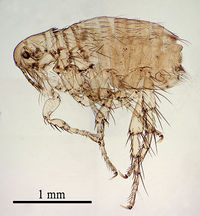Difference between revisions of "Ctenocephalides canis"
| (27 intermediate revisions by 3 users not shown) | |||
| Line 1: | Line 1: | ||
| − | {{ | + | {{OpenPagesTop}} |
| + | Also known as: '''''Dog flea | ||
| + | |||
| + | {{Taxobox | ||
| + | |name = ''Ctenocephalides canis | ||
| + | |kingdom = | ||
| + | |phylum = | ||
| + | |class = [[:Category:Insecta|Insecta]] | ||
| + | |sub-class = | ||
| + | |order = [[Siphonaptera]] | ||
| + | |super-family = | ||
| + | |family = Pulicidae | ||
| + | |sub-family = | ||
| + | |genus = | ||
| + | |species = ''Ctenocephalides canis | ||
| + | }} | ||
| + | |||
| + | [[Image:Ctenocephalides canis.jpg|200px|thumb|right|''Ctenocephalides canis'' <br> Luis Fernández García 2007, Wikimedia Commons]] | ||
==Hosts== | ==Hosts== | ||
| Line 5: | Line 22: | ||
==Identification== | ==Identification== | ||
| − | ''C. canis'' is very similar to ''[[Ctenocephalides felis| C.felis]]''. The first genal spine is 0.5 times the length of the second, and ''C. canis'' has a more rounded head than ''C. felis.'' | + | ''C. canis'' is very similar to ''[[Ctenocephalides felis| C.felis]]'', and of the order [[Siphonaptera]]. The first genal spine is 0.5 times the length of the second, and ''C. canis'' has a more rounded head than ''C. felis.'' |
| + | |||
| + | See [[Flea Structure|general flea structure]]. | ||
==Life Cycle== | ==Life Cycle== | ||
| − | Again, very similar to ''C. felis.'' The eggs are produced soon after arrival on the host. | + | Again, very similar to ''C. felis.'' The eggs are produced soon after arrival on the host. They then hatch into larvae, which undergo two moults before entering the pupae stage. The pupae may remain dormant for a year or longer, and are stimulated to hatch by mechanical stimuli such as vibrations. |
Under suitable conditions, the complete life cycle can take as little as 3 weeks. | Under suitable conditions, the complete life cycle can take as little as 3 weeks. | ||
| − | |||
| − | + | See [[Flea Life Cycle|general flea life cycle]]. | |
| − | + | {{Learning | |
| + | |literature search = [http://www.cabdirect.org/search.html?rowId=1&options1=AND&q1=%22Ctenocephalides+canis%22&occuring1=title&rowId=2&options2=AND&q2=&occuring2=freetext&rowId=3&options3=AND&q3=&occuring3=freetext&x=67&y=11&publishedstart=yyyy&publishedend=yyyy&calendarInput=yyyy-mm-dd&la=any&it=any&show=all ''Ctenocephalides canis'' publications] | ||
| + | |Vetstream = [https://www.vetstream.com/canis/search?s=flea Fleas] | ||
| + | }} | ||
| − | |||
| − | + | {{OpenPages}} | |
| + | [[Category:Dog Parasites]] | ||
| + | [[Category:Fleas]] | ||
| − | [[Category: | + | [[Category:Expert_Review]] |
| − | |||
| − | |||
Latest revision as of 17:26, 4 June 2016
Also known as: Dog flea
| Ctenocephalides canis | |
|---|---|
| Class | Insecta |
| Order | Siphonaptera |
| Family | Pulicidae |
| Species | Ctenocephalides canis |
Hosts
Dogs, cats, rabbits, rats, foxes and humans
Identification
C. canis is very similar to C.felis, and of the order Siphonaptera. The first genal spine is 0.5 times the length of the second, and C. canis has a more rounded head than C. felis.
Life Cycle
Again, very similar to C. felis. The eggs are produced soon after arrival on the host. They then hatch into larvae, which undergo two moults before entering the pupae stage. The pupae may remain dormant for a year or longer, and are stimulated to hatch by mechanical stimuli such as vibrations.
Under suitable conditions, the complete life cycle can take as little as 3 weeks.
| Ctenocephalides canis Learning Resources | |
|---|---|
To reach the Vetstream content, please select |
Canis, Felis, Lapis or Equis |
 Search for recent publications via CAB Abstract (CABI log in required) |
Ctenocephalides canis publications |
Error in widget FBRecommend: unable to write file /var/www/wikivet.net/extensions/Widgets/compiled_templates/wrt6936364f98e888_32527491 Error in widget google+: unable to write file /var/www/wikivet.net/extensions/Widgets/compiled_templates/wrt6936364fa2f7f2_75215063 Error in widget TwitterTweet: unable to write file /var/www/wikivet.net/extensions/Widgets/compiled_templates/wrt6936364fb58e58_25053817
|
| WikiVet® Introduction - Help WikiVet - Report a Problem |
